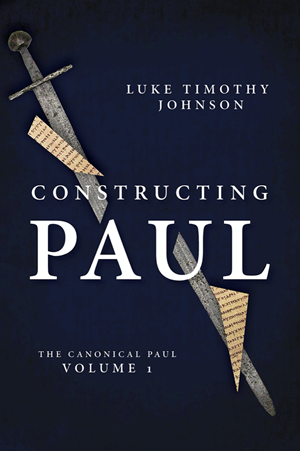(Re)Constructing Paul

Luke Timothy Johnson is proposing that we learn from how the church has read Paul more. Not that we ignore scholarship – and he’s a preeminent NT scholar – but that the scholarly approach is not the church’s approach, and the latter has something to say for how we understand Paul. His new project is called Constructing Paul since Paul has been de-structed in some ways. (The word “deconstructed” does not mean “criticized” but more shown to be full of internal contradictions.)
Paul matters because his is the most distinctive and theological voice absorbed and expanded in the history of the church. What kind of Paul gave rise, one might ask, to a place like St Paul’s Cathedral?
But the historical critical enterprise has time and time again delved into Paul and left us with a Paul who doesn’t match the “canonical” (more below) Paul. Johnson is a committed Roman Catholic and he’s cautious about the assumed conclusions of the dating of the Pauline letters. He grills some of its main conclusions and assumptions by exposing its methods as inadequate. He’s not, however, affirming the conservative’s traditional viewpoints. He’s subjecting much of Pauline scholarship to scrutiny.
He sorts very briefly through the various approaches to Paul: old, new, apocalyptic perspectives, the Greco-Roman Paul along with the socio-pragmatic, critical siftings of Paul in liberation, feminist, African American, and postcolonial Pauls.
A few observations from his exciting introduction.
First, the Paul most know is the Paul of Romans and Galatians. In a powerful footnote, Johnson writes:
The dominant role played by Romans in constructing Paul’s theology is equally visible, for example, in Bultmann’s Theology of the New Testament and in Dunn’s Theology of Paul the Apostle. Bird’s Anomalous Jew deals entirely with Galatians; Barclay’s Paul and the Gift focuses exclusively on Galatians and Romans; Wright’s Paul and the Faithfulness of God is entirely dominated by Galatians and Romans. And Campbell’s massive (1218-page) tome, Deliverance of God, is in reality a study of Galatians and Romans. He devotes fifteen pages to Philippians 3, and fourteen pages to four passages in 1 Corinthians, 2 Corinthians, and 1 Thessalonians, under the rubric “loose ends”!

OK, but this is a bit heavy as I’m not so sure this is accurate and unwarranted. Romans, if one has to examine Paul’s theology, surely is given first prize. But, yes, when it comes to Paul’s theology, Romans and Galatians are the core of where scholarship has turned.
Second, Johnson goes where few are willing to go. He thinks the so-called seven-letter-canon of Pauline letters deemed authentic are anything but coherent. Many of us have said something like this over the years but the “canon” of authentic letters is largely undisturbed because it pushes one off the platform of acceptable, reputable scholarship. Johnson then does something that no one does: he sees five clusters of Pauline letters with two stragglers:
(1) Galatians and Romans
(2) Corinthians
(3) Colossians and Ephesians
(4) Pastoral Epistles
(5) Thessalonians
(6) Philippians and Philemon
No two clusters are alike enough to make for the so-called-authentic-letter canon. We have, then, a diverse collection of “Pauline” letters in the NT canon and Johnson thinks we should “construct” the Pauline material in all its diversity in the canon itself. I love this statement:
The canonical Paul is the lectionary Paul, the preached Paul, the Paul of theology among those not captive to the dogmas of historical criticism.
Jesus Creed is a part of CT's
Blog Forum. Support the work of CT.
Subscribe and get one year free.
The views of the blogger do not necessarily reflect those of Christianity Today.


















